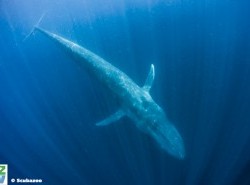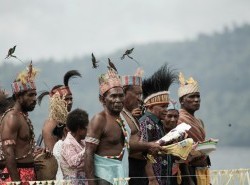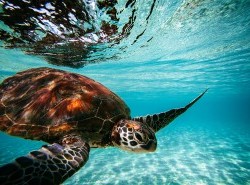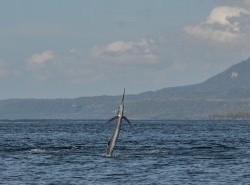I love the first light of day when I’m surrounded by nothing but water in every direction. There is a magic to it - a deep feeling of peace which I find energising. It’s the same when I’m in the water - when the first beams of light waken the reef, bringing forth its myriad colours. Trying to capture these moments with a camera has become one of my favourite pursuits. Boats are my office - I work as a cruise director on small vessels, sailing to some of the most remote and beautiful parts of the Indonesian archipelago. And more than anywhere else, the Bird’s Head Seascape in West Papua - the global epicentre of marine biodiversity. But while I’m a dive master, I prefer to shoot underwater on breath hold only.
Freediving under a wave. It is so much fun to play in the waves and observe how they look from underneath. It almost looks like a thunderstorm & the sense of its power is awesome
I makes sure my camera is always set up because you never know what you might encounter. Because I prefer photographing on a single breath, I can just slip in the water - no gearing up. To me, skin diving is true freedom. And shooting breath hold adds a whole new level of focus to the activity.
Everyone's favourite - schooling jacks shot in Raja Ampat
These short moments - when I take a breath and descend to seek out images - are the same as sitting in meditation for me. Drawing awareness inwards, to my breath and my heartbeat, I try to keep my gaze wide and soft, as if my eyes were still closed, before I slip into the water.
You need to finding neutral buoyancy pretty fast and then keep the camera very steady. Your bottom time is obviously far more limited than with scuba diving, so you need to make quick decisions, move decisively and focus on accuracy. It’s a challenge I love every time, whatever the outcome. And the photography has been one of my greatest teachers in terms of free diving too.
Underneath a Porites hard coral grows a beautiful soft coral, a dendronephthya species that doesn't depend on sunlight. A tightly packed school of golden sweepers and silversides creates a mantle around the coral bommy, so that I can't see what might be underneath!
Once I’ve picked my subject, I begin by positioning my body and angling the strobes on the camera, adjusting the settings and white balance according to the depth. Meters and minutes become secondary as I concentrate on these tasks. Of course one of the biggest advantages of breathhold photography is that you don’t make any noise.
On just a square meter of a random coral bommy in Raja Ampat you could easily spend an hour observing all the different manifestations of life...
Sponges, hydrozoas, crinoids, hard coral, soft coral, sea squirts, tunicates, leather coral, crustaceans, nudibranches...
Gliding silently through these shifting shades of blue allows me to get close to my aquatic friends. And of course there are no bubbles. I shoot most of my images with a fisheye lens (15mm), so I have to get really close. Especially with sharks and rays, this extra challenge can be a real thrill as you mindfully approach the animal and connect with it.
The tentacles of a sea anemone. They are members of the group of water-dwelling, surprisingly predatory animals. Like this bulb anemone, Anthozoas often have large polyps for digesting larger prey. Many sea anemones benefit form symbiotic relationships with single-celled algae like the zooxanthelea that live within their cells. In order to get the algae to produce more sugar through photosynthesis, the anemone widens and expands the surface area at the tips of its tentacles.
When we freedive, an ancient biological process kicks in. It’s called the mammalian dive reflex and it is the legacy of our aquatic ancestors. When we submerge even just our faces in cold water, or go to greater depths, our heart rate immediately begins to slow and through peripheral vasoconstriction (the narrowing of blood vessels) our blood shifts from our extremities into the life support system of lungs, heart and brain.
The porcupine ray is a rare species of stingray and the only member of its genus. I found this bottom dweller at a depth of only 5 meters on a sandy patch in the middle of a vast coral garden. It lacks the venomous stinging spine of its compatriots, but an adult can still defend itself effectively with the many large, sharp thorns found over its disc and tail. Unregulated fishing and the use of the rays' thick, thorny skin has decreased their number immensely, so that the species has been listed as Vulnerable by the International Union for Conservation of Nature (IUCN).
This allows us, to be more efficient with our oxygen consumption under water. Also, it activates our parasympathetic nervous system, which is the calming one. We slow down.
Up close to the tail of a swimming tasseled wobbebong shark, a family member of the carpet sharks. It is rare to see these nocturnal creatures swimming freely during the day. The small weedlike whisker lobes surrounding the wobbegong's jaw act as additional camouflage as well as providing sensory barbs.
Meeting sea creatures and exploring the underwater environment with a camera distracts you from the ever present voice in your head. It helps bring you into the present. it’s difficult to express just how vital and immediate these encounters on breath hold actually feel. There isn’t a comparable habitat where you can get so close to animals - witnessing predators and prey in action, getting drawn into the macro world, zooming in to observe tiny coral polyps feeding on plankton.
(1) There are not many places on our planet where black and soft coral grow so close to the surface. On a clear day like in this image, you can even see the terrestrial flora - almost reaching out to touch the coral. (2) A free diver ascends from a a cave. (3) Dendronephthya soft coral, sponges and tunicates growing on a fallen tree. The waters of Raja Ampat are so rich, that any kind of object like this tree trunk is immediately inhabited and overgrown by filter feeders and invertebrate life. All shot at The Passage, Aljui Bay, Raja Ampat
Breath hold photography loosens the hold of the strong protection mechanisms of the body. That can be dangerous too of course and you need to develop judgement, knowing when it is time to head to the surface. Free diving requires training and should never be done alone.
Even on a rainy day in spooky channel the world below shines beautifully if lit up with strobes. Split shots show the unity of the world above and below...
Cassiopea (upside-down jellyfish) are found in warmer coastal regions around the world, including shallow mangrove swamps, mudflats, canals, and the Tropics. The medusa usually lives upside-down on the bottom, which has created their common name. For this image I gently lifted the Cassiopea up to the surface, where its gorgeous skirt reflects like in a mirror.
After years of shooting on breathhold and attempting deeper dives regularly out on the reefs, I wanted to learn more about the sport and improve my technique. So I decided, to follow the educational system of the Apneista dive school (apneista.com) in Amed, northeast Bali, up to instructor level.
For moments like these I happily leave my camera behind quite often - there isn't much that comes close to a freedive play with manta rays
Keeping the big, underwater camera set up steady while aiming for an image is a challenge. In this shot I was surrounded by Demoiselle fish. Jemeluk Bay, Amed, Bali
It was only by doing the programme that I realised how dangerous this sport can be, and how little I actually knew! I highly recommend all ocean lovers – whether surfers, spear fishers, scuba divers or snorkelers - to join at least a basic freediving course with professionals in order to be safer and have more confidence in the water. And then pick up a camera and really go deep!










